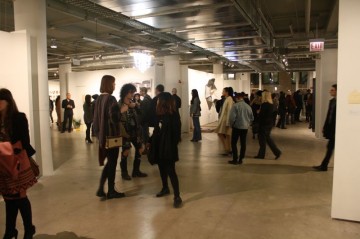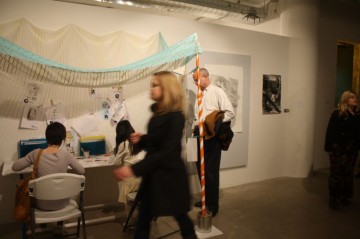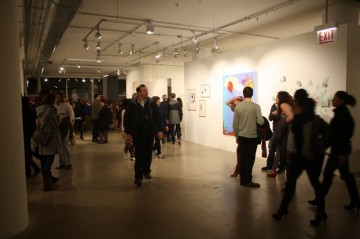Last Friday, I got off the subway and felt the crisp, eight o’clock Chicago evening air and saw something I was not expecting: a line around The School of the Art Institute’s (SAIC) gallery building. The lines snaked along busy State Street, winding down and around the side street. Puffs of cigarette smoke and ringing cellphones surrounded everyone waiting to get into the building to see the 2011 SAIC BFA show.
The cigarette smoke and cell phone jingles were primarily coming from art students, but this year, I saw more people off the street than I would usually see at BFA shows. I asked those around me what brought them there, and what compelled them to stand in a cold Chicago night to get into a show of undergraduate artwork.
A couple who appeared to be in their late fifties to early sixties stood behind me with another couple who also appeared to be about their age. I asked them if they knew an artist in the show, and they replied simply, “No. We come here every year to buy art.” They went on to tell me they desired this venue for collecting because it was affordable, but even more importantly, it was completely refreshing and undigested.
They all explained, shaking their heads in agreement to one another that this was where the pulse of art really was and this was the place to meet with young artists and acquire work. They went on to say they would also be attending the MFA show telling me, “And we’ll wait in line for that, too!”
They were right, too. Most of the art we waited in line to see was totally pure, untainted by art critics’ analysis and generally unbeknownst to the market stratagems of collectors and dealers.
After gaining admittance into the building and then into the gallery, I saw what these people were saying to me within the first ten minutes I wandered around. Elderly people, middle-aged people, and hip thirty- and forty-something couples walked around taking cards, negotiating with the artists out of their desire to purchase work, and taking photographs of selected works that piqued their interest. From this, I imagined a dining room table somewhere with these photos splayed out, like a detective arranges crime scene photos, as a way to pick the ones they would decide upon buying.
I had never attended the BFA or MFA show because of my unfortunate, claustrophobic issues with crowds, but this year I went to see a couple of friends who were in it. I asked people who had come to these shows in the past if they were always visited by such a diverse crowd of people, if there was always a line halfway around the block. I was told that it gets progressively busier and more diverse each year.
My thoughts, of course, went immediately to the economy. It occurred to me that maybe even blue-chip gallery and auction house collectors were also in attendance that night. The majority of the work was, in my opinion, very strong, very realized, and definitely seemed in possession of that pulse to which the people I spoke with in line had alluded.
There was an electricity in the crowded rooms of the gallery, the buzz of conversation in whispers that would be occasionally sliced with a large and excited laugh as we all darted our eyes excitedly, taking it all in.
Beyond the fact that these exhibitions for BFA and MFA students are truly significant moments in young artists’ careers, they are also rehearsals for the arena many of them will enter and be a part of for years to come. In the artists’ electrified eyes, I could see successful accomplishment, as well as the massive crowd that continually demonstrated the social prowess and magnitude of art.







